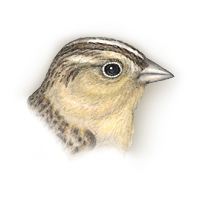|
Field
Guide IDs: BREEDING:
Grassland,
cultivated fields, prairie, old fields, open
savanna. 2 broods, 3? in FL. DISPLAYS:
Courtship: low
fluttering flight by male, silent or with song, the
latter answered by female trill. Male may chase
female while singing. NEST:
Sunk in slight
depression, rim flush with ground level, well
concealed by overhanging grass and forbs, arched or
domed at back; of dried grass, lined with fine
materials. EGGS:
Creamy white,
marked with reddish-brown, occ wreathed. 0.8 (19
mm). DIET:
Includes
invertebrates, grass and forb seeds. CONSERVATION:
Winters s to n
S.A., Greater Antilles. Blue List 1974-86;
declining in many areas, esp FL and Appalachians.
FL subspecies Endangered. Nests often destroyed by
mowing in cultivated grassland; despite loss of
cover, birds stay and then suffer increased losses
from predators. Uncommon cowbird host. NOTES:
Semicolonial
breeding groups of 3-12 pairs. Local abundance
fluctuates greatly between years. Male territorial
display directed at other males alternates song
with crouched display of lowered head and
fluttering wings; territorial defense declines
after young hatch. Female performs distraction
display of short fluttering flight followed by
feigned injury with spread wings and tail. Does not
form winter flocks. Fairly rare and
local summer resident in grassland habitats at the
Dish, where 1-2 pairs nest in most years. No
records elsewhere on campus. ESSAYS: Blue
List;
Birds
and the Law;
Territoriality;
Distraction
Displays REFERENCES:
Kale, 1978; Wiens,
1973. |
